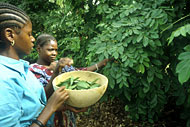
Entrepreneurs don’t grow on trees, but with a little help from the U.N., poor families around the world are starting their own small businesses using what is already growing on those trees. An innovative new approach from the Food and Agriculture Organization helps poor villagers in developing countries to turn forests into cash income — without felling the trees.
Fruits, nuts, herbs and spices, resins, gums, fibres — all these non-wood forest products (NWFPs) provide many millions of poor families around the world with food, nutrition and income. Indeed, some 80 percent of the population of developing countries use these products in one way or another to meet health and nutritional needs, according to FAO.
"We believe that people could do even more with these renewable resources including earning more money for their families," says Sophie Grouwels of FAO’s Forestry Department.
That is why FAO established a program, with funding from the Norwegian government, to do just that. It’s called Community-based Tree and Forest Enterprise Development (CBED).
Tapping the Wealth of Forests Without Destroying Them
The project helps poor communities set up, sustain and grow small businesses while giving them incentives to better manage and protect their resource base, allowing them to tap the wealth of nearby forest resources without depleting them.
In one CBED project in Laos, six pilot projects were established in the poorest villages of the heavily-forested country and the results so far have been extremely encouraging.
In Ban Lack, a grassroots cooperative manufacturing rattan table and chair sets, bettered their production techniques to earn 20 percent more on each set they sell. A group of women in nearby Ban Nathong identified a new market for mushrooms, established a growing house, made connections with retailers, and boosted their monthly incomes by $108 (USD).
All in all, 10 community-level businesses employing 239 people were established. Increases in the incomes of participating households ranged from US$5 to US$70 per month — 15 to 50 percent more than they were making before.
"The villagers not only improved their incomes, but also acquired important business skills and experience and drafted up sustainable resource management plans for the NWFPs upon which their livelihoods depend," notes Sophie Grouwels.
At the same time, small village development funds were established using the profits as a way to provide locals with access to the credit they needed to create new or scale-up existing operations, she adds.





















Trees as symbionts
Makes me wonder what these resourceful folks would make of the acorns, pine cones, and horse-chestnuts that we rake up by the bagful around here…